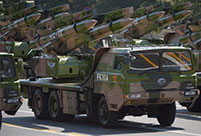


BEIJING, Sept. 12 -- Dealing with the effects of climate change is an uphill battle that involves all nations, big and small, rich and poor.
During his upcoming state visit to the United States in late September, Chinese President Xi Jinping and his U.S. host Barack Obama are likely to exhibit even stronger aspiration and resolution to help our planet, together with other countries, win the make-or-break battle.
SHARED WILLINGNESS
"There is increasing cooperation between the two countries (China and the United States) on climate issues," said Nathaniel Ahrens, director of China Affairs at the University of Maryland, calling it a "positive factor" of Xi's upcoming visit.
Meanwhile, Chinese Ambassador to the United States Cui Tiankai also regarded tackling climate change as "a priority" for the two countries at the current stage.
China, the world's biggest developing country, needs to deal with domestic air pollution, while the United States, as the biggest developed country, suffers frequently from extreme weather conditions like droughts and hurricanes.
As it is feared that the combination of extreme weather events could possibly rise four-fold over the next century if greenhouse gas emissions continue climbing at their present rate, it is beyond all doubt that creating a favorable environment for generations to come has become the shared aspiration of China and the United States, the world's top two emitters of greenhouse gases.
Combating climate change is also about building a community of common destiny, as all efforts on climate change go beyond national boundaries.
Prior to a United Nations (UN) climate conference scheduled later this year in Paris, France, China and the United States have agreed to jointly mitigate what they labeled "one of the greatest threats facing humanity."
The latest meeting between Xi and Obama, which was on the sidelines of the 2014 APEC Summit in Beijing, resulted in, among others, a joint statement on climate change, in which the two countries announced their respective post-2020 goals of coping with climate change.
The two countries will also jointly push international climate change negotiations for a new agreement to be reached as planned in Paris, according to the statement.
The announcement creates "a great opportunity" for the low-carbon energy transition in both countries and make the development of renewables and the improvement of energy efficiency "a hot spot" in bilateral cooperation, according to an energy expert interviewed by Xinhua.
"The mitigation of climate change is not just about the actions that prevent ourselves from damaging the planet, but more importantly, about how we could have a sustainable development pathway," said Liu Zhu, a research fellow at Harvard University whose research focuses on carbon emission and sustainability science.
INDIVIDUAL COMMITMENTS
Individually, China and the United States have declared their own goals in emission reduction.
In June, China pledged a bold "Intended Nationally Determined Contribution" (INDC) to cut carbon dioxide emissions per unit of gross domestic product (GDP) by 60 to 65 percent from the 2005 level by 2030, according to a document submitted to the Secretariat of the UN Framework Convention on Climate Change.
The world's second-largest economy intends to achieve its peaking of carbon dioxide emissions around 2030 and will do its best to peak early, according to the INDC.
Chinese Foreign Ministry spokesperson Hong Lei on Tuesday told a daily press briefing that China is willing to work with all parties to help the Paris summit reach a comprehensive and balanced accord on the principle of common but differentiated responsibilities, equity and respective capabilities.
"As there is not much time left before the summit, all parties need to speed up the negotiation with utmost sincerity so as to build consensus to the greatest extend," Hong said.
For its part, the Obama administration in August announced the final and tougher version of its "Clean Power Plan," which the president said will reduce carbon pollution from power stations by one-third over the next 15 years, making it "the single most important step the United States has ever taken in the fight against climate change."
The plan, though opposed by Congressional Republicans who said the decision will hurt coal-mining states and raise electricity rates, was welcomed by U.S. Environmental Protection Agency chief Gina McCarthy, according to whom gases linked to climate change will be reduced at a faster rate than they would have been before.
CHALLENGE AHEAD
Based on the aforementioned joint and separate efforts, one key challenge facing future Sino-U.S. cooperation in climate change involves how the two countries can ensure win-win results for both economic development and environmental protection.
"There is no shortcut," Liu said, stressing the need for both countries to keep working on technology innovation, education and efficiency improvement.
The fact that developing countries will inevitably compromise their development pace in exchange for a reduction in carbon emission not only makes the principle of common but differentiated responsibilities justifiable, but also calls for the developed countries to provide necessary financial and technological support to their developing counterparts.
On this front, Liu argued that close cooperation between Chinese and U.S. researchers is crucial, so as to "value the detailed technology and carbon emission status" and, consequently, to transfer technology and funds from the developed countries to the developing ones in support of their mitigation efforts.
Meanwhile, ambassador Cui believed that both countries have to realize that battling climate change will, in fact, not impede growth but generate more jobs and opportunities, and bring more practical cooperation.
For instance, Chinese companies can meet the U.S. demand for solar panels and wind turbines, while U.S. products and expertise may satisfy China's need for building more nuclear power plants, applying more clean-coal technology and increasing the exploration and consumption of natural gas.
All in all, President Xi's upcoming visit to the United States will see the two countries put their heads together in an effort to help the world reduce greenhouse gas emission more effectively. Enditem
Xinhua reporters Tian Dongdong and Tamara Treichel in Beijing, Lin Xiaochun in Washington contributed to the story.
 Models change clothes on street in Hangzhou
Models change clothes on street in Hangzhou Charming iron ladies in China's upcoming V-Day celebrations
Charming iron ladies in China's upcoming V-Day celebrations In pics: armaments displyed in massive military parade
In pics: armaments displyed in massive military parade Charming Chinese female soldiers
Charming Chinese female soldiers Volunteers required not taller than 5ft 5in
Volunteers required not taller than 5ft 5in  Czech pole dancing master teaches in Xi'an
Czech pole dancing master teaches in Xi'an Shocked! PLA smokescreen vehicle drill
Shocked! PLA smokescreen vehicle drill Foreigners experience tranditional Chinese wedding
Foreigners experience tranditional Chinese wedding Blind date with bikini girls in Nanjing
Blind date with bikini girls in Nanjing Living heritage
Living heritage More SOE reforms on the way
More SOE reforms on the way NYT shifts refugee crisis attention to China
NYT shifts refugee crisis attention to China Govt cracks down on editors accepting bribes to delete negative online reports
Govt cracks down on editors accepting bribes to delete negative online reportsDay|Week